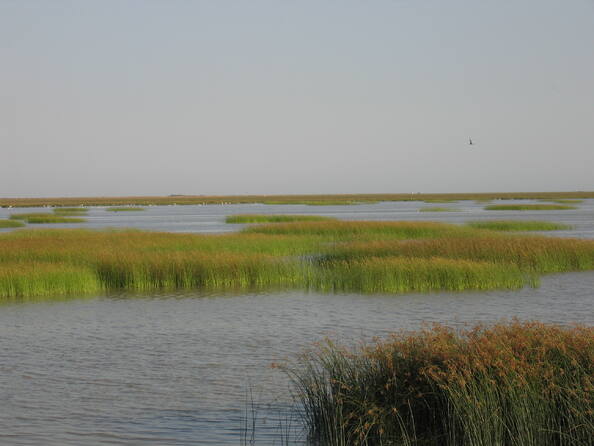Countries<Spain<Andalucía [Andalusia]<Sevilla< Parque Nacional de Doñana
Doñana is a meeting point of strong and varied natural dynamics that has favoured the formation of a multiplicity of habitats and ecosystems thanks to the combined action of continental and marine agents. For this reason, the Doñana National Park, located in the wide Gulf of Cadiz in the Atlantic Ocean, in the provinces of Huelva and Seville, offers the visitor a beautiful and attractive mosaic of environments and landscapes, constituting the largest ecological reserve in Europe. It owes its estuary character to the mouth of the Guadalquivir River, which articulates the orography and landscape of a large part of southern Spain.
In this context, where water in its various manifestations is the modelling element par excellence, the great ecosystems of Doñana come together: 40 kilometres of virgin beaches and impressive fronts of mobile dunes, coastal forests of pine, juniper and juniper trees, cork oak groves and Mediterranean scrubland, lagoons and the marshes. The latter is the most important wetland ecosystem in terms of its size and representativeness. It is one of the few protected areas in the world where representative examples of the excellent quality and state of conservation of these habitats converge in its more than 50,000 hectares.
The relevance of this protected area also lies in the large number of species it is home to, many of which are emblematic and endangered. Doñana is one of the essential natural refuges for the conservation of endangered species such as the Iberian lynx, the most endangered feline in Europe, the imperial eagle, the marbled teal or the white-headed duck. There are also numerous species of birds of prey and endemic plant species and others that are highly endangered, such as the coastal juniper. Finally, it is an irreplaceable enclave on the migratory routes for hundreds of thousands of birds (ardeids, waders, ducks, waders, etc.), whose survival depends on the good health of these wetlands, which make Doñana the largest wintering site in Western Europe.
It is also essential to mention the traditional practices for the use of resources that are preserved as important local values: the hunting "preserves" (former royal hunting grounds), forestry, livestock, fish, shellfish, beekeeping or pineapple... Finally, Doñana is home to one of the most popular religious events in Europe, the Pilgrimage of El Rocío, an emblematic model of the link between spirituality and nature, which makes this park a Sacred Natural Space.
For all these reasons, in 1994 the Doñana National Park was inscribed on the World Heritage List.
Doñana es un punto de encuentro de fuertes y variadas dinámicas naturales que ha favorecido la formación de una multiplicidad de hábitats y ecosistemas gracias a la acción combinada de agentes continentales y marinos. Por esto, el Parque Nacional de Doñana, ubicado en el amplio Golfo de Cádiz del Océano Atlántico, en las provincias de Huelva y Sevilla, ofrece al visitante un hermoso y atractivo mosaico de ambientes y paisajes, constituyéndose como la mayor reserva ecológica de Europa. Debe su carácter de estuario a la desembocadura del río Guadalquivir, que articula la orografía y el paisaje de una extensa parte del Sur de España.
En este contexto, donde el agua en sus variadas manifestaciones es el elemento modelador por excelencia, se dan encuentro los grandes ecosistemas de Doñana: 40 kilómetros de playas vírgenes y unos impresionantes frentes de dunas móviles, bosques litorales de pinares, sabinas y enebros, alcornocales y matorral mediterráneo, lagunas y la marisma. Éste último es el más importante ecosistema de humedal por su extensión y representatividad. Se trata de uno de los pocos espacios protegidos en el mundo en el que convergen, en sus más de 50.000 ha, ejemplos representativos de excelente calidad y estado de conservación de estos hábitats.
La relevancia de este espacio protegido radica también en el alto número de especies que alberga, muchos de ellas emblemáticas y amenazadas. Doñana es uno de los refugios naturales imprescindibles para la conservación de especies en peligro de extinción como el lince ibérico, el felino más amenazado de Europa, el águila imperial, la cerceta pardilla o la malvasía cabeciblanca. Encontramos asimismo numerosas especies de rapaces y especies vegetales endémicas y otras muy amenazadas, como el enebro costero. Finalmente es un enclave insustituible en las rutas migratorias para cientos de miles de aves (ardeidas, zancudas, anátidas, limícolas,…), cuya supervivencia depende de la buena salud de las estos humedales, que hacen de Doñana el mayor cuartel de invernada de Europa Occidental.
Es imprescindible mencionar también las prácticas tradicionales de aprovechamiento de los recursos que se preservan como importantes valores locales: los “cotos” de caza (antiguos cazaderos reales), aprovechamientos forestales, ganaderos, piscícolas, marisqueros, apícolas o piñeros… Por último, en Doñana se celebra unos de los acontecimientos religiosos más multitudinarios de Europa, la Romería de El Rocío, modelo emblemático de vinculación de espitirualidad y naturaleza, que convierten a este parque en un Espacio Natural Sagrado.
Por todo esto, en 1994 el Parque Nacional de Doñana fue inscrito en la Lista de Patrimonio Mundial.
